"Cherishing Little Steps - A Haven for Baby and Family Journeys"
Infant Car Seat Safety Tips
Did you know that car crashes are the leading cause of death for children under the age of 13? When it comes to keeping your little one safe on the road, it’s crucial to follow proper infant car seat safety tips.
By choosing the right car seat, installing it correctly, and securing your baby with the harness, you can significantly reduce the risk of injury during a collision.
In this guide, we will explore essential tips to ensure your baby’s safety, such as understanding weight and height limits, avoiding bulky clothing, and staying informed about recalls and safety updates.
Your baby’s well-being is our top priority, so let’s dive in and learn everything you need to know about infant car seat safety.
Key Takeaways
- Consider the infant’s age, weight, and height when selecting a car seat.
- Rear-facing car seats are the safest option for infants.
- Regularly check and monitor weight and height limits of the car seat.
- Thoroughly read the car seat manual and ensure proper installation.
Choosing the Right Car Seat
When choosing the right car seat for your infant, it’s important to consider their age, weight, and height. These factors play a crucial role in ensuring the safety and comfort of your child during car rides.
First and foremost, you need to make sure that the car seat is installed correctly. Improper installation can greatly compromise the effectiveness of the seat in protecting your baby in the event of a collision. To ensure proper installation, always follow the manufacturer’s instructions and consult with a certified car seat technician if needed.
Additionally, it’s essential to look at car seat safety ratings. These ratings provide valuable information about the seat’s performance in crash tests and its overall safety features. By choosing a car seat with high safety ratings, you can have peace of mind knowing that your little one is well-protected.
Rear-Facing Is the Safest Option
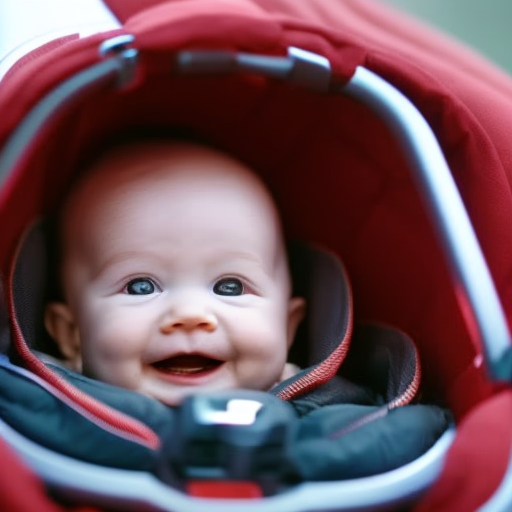
To ensure the utmost safety for your infant, it’s recommended to have them ride in a rear-facing car seat. Rear-facing car seats provide numerous benefits and are considered the safest option for young children.
When a car crash occurs, the impact is distributed evenly across the back of the car seat, reducing the force on your child’s neck and spine. This is particularly important for infants, as their neck muscles aren’t fully developed.
The benefits of rear-facing car seats extend beyond just the early stages of infancy. Studies have shown that keeping your child in a rear-facing position for as long as possible, also known as extended rear-facing, can greatly reduce the risk of injuries in the event of a crash. In fact, it’s recommended to keep your child in a rear-facing car seat until they reach the maximum weight or height limit specified by the car seat manufacturer.
Extended rear-facing not only provides enhanced protection for your child, but it also allows their body to mature and develop further before transitioning to a forward-facing position. This extra time can make a significant difference in ensuring their safety and well-being.
Understanding the Weight and Height Limits
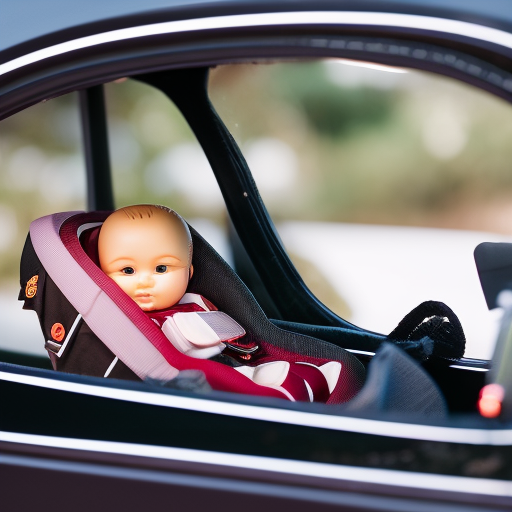
Make sure you understand the weight and height limits of your infant car seat. This is crucial for the safety and well-being of your child during car rides.
Here are a few important points to consider:
-
Understanding the age requirements: Each infant car seat has specific weight and height limits that must be followed. These limits are designed to ensure that your child is properly protected and secure. It’s important to know the age requirements for your particular car seat and to adhere to them accordingly.
-
Importance of proper installation: Proper installation of the car seat is essential for its effectiveness. Make sure you carefully read the instruction manual and follow all the steps correctly. If you’re unsure about the installation process, seek help from a certified technician or contact the car seat manufacturer for guidance.
-
Regularly check for weight and height limits: As your child grows, their weight and height will change. It’s crucial to regularly check and monitor these limits to ensure that your child is still within the safe range for the car seat. If your child exceeds the weight or height limits, it may be time to transition to a different type of car seat.
-
Consult with a professional: If you have any doubts or concerns about the weight and height limits of your infant car seat, it’s always advisable to consult with a professional. They can provide you with the necessary guidance and support to ensure that your child is safe and secure during car rides.
Installing the Car Seat Properly
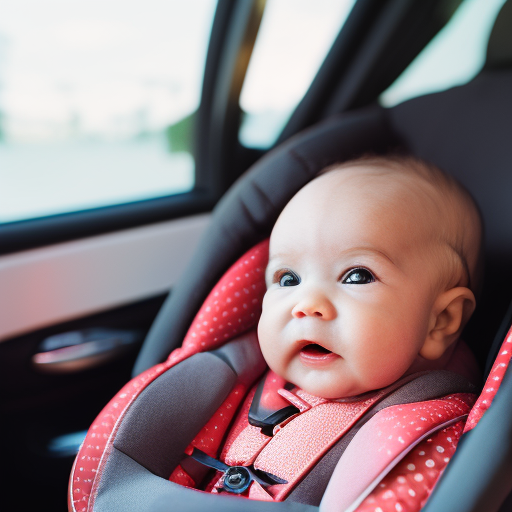
Ensure your infant car seat is properly installed for optimal safety and protection. Proper installation is crucial to ensure the car seat functions as intended during a collision. Here are some tips to help you install your car seat correctly and avoid common mistakes.
Firstly, read the car seat manual thoroughly before installation. Each car seat has its own specific installation instructions, so it’s important to follow them carefully. Pay close attention to the correct positioning of the seat, the type of seatbelt or LATCH system to be used, and any additional requirements.
Next, make sure the car seat is tightly secured. There should be minimal movement when you try to wiggle it from side to side or front to back. If the seat moves more than an inch in any direction, it isn’t properly installed. Double-check the seatbelt or LATCH system and adjust it accordingly.
Another common mistake isn’t adjusting the harness straps correctly. The straps should be snug and lie flat against your baby’s chest, with the chest clip at armpit level. Ensure that the harness is at or below your baby’s shoulders for rear-facing seats.
Lastly, have your car seat installation checked by a certified technician. They can help you ensure that the seat is installed correctly and provide guidance on any adjustments that need to be made.
Securing Your Baby With the Harness
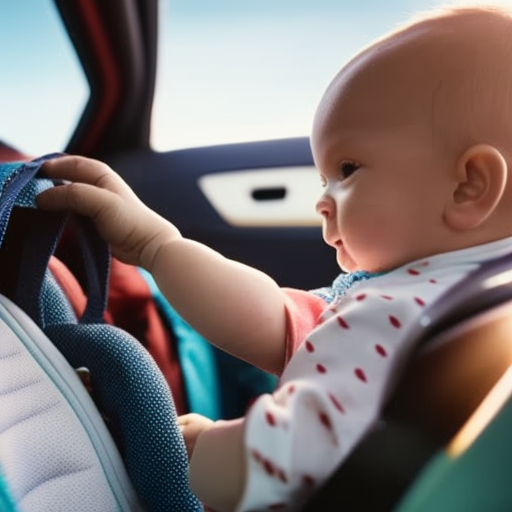
Once you have properly installed your infant car seat, it’s important to securely fasten your baby with the harness. The harness is what keeps your baby safe and protected in the event of a sudden stop or crash. Here are some essential tips to ensure that the harness is adjusted correctly and fits your baby properly:
-
Adjusting harness tension: Make sure the harness is snug but not too tight. You should be able to fit only two fingers between your baby’s chest and the harness strap. If the straps are too loose, they won’t provide adequate protection. If they’re too tight, they may cause discomfort or restrict your baby’s breathing.
-
Checking for proper fit: The shoulder straps should be positioned at or below your baby’s shoulders. The chest clip should be at armpit level to keep the straps securely in place. The harness should be snug enough that you can’t pinch any excess straps at the shoulder.
-
Avoid bulky clothing: Bulky clothing, like thick jackets or snowsuits, can prevent the harness from fitting properly. Instead, dress your baby in thin layers and use a blanket for warmth.
-
Regularly check the fit: Babies grow quickly, so it’s important to regularly check the fit of the harness. Adjust the straps as needed to ensure a secure and comfortable fit for your growing baby.
Positioning the Chest Clip Correctly
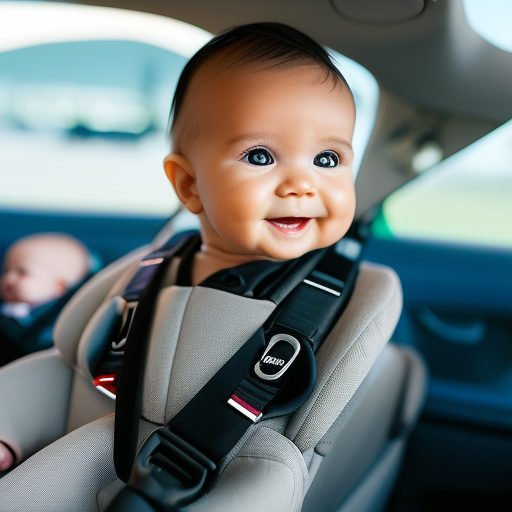
Secure your baby’s harness properly by positioning the chest clip correctly. The chest clip is an essential part of your baby’s car seat safety, as it helps to secure the harness in the correct position. Proper chest clip placement ensures that the harness is snug and secure, reducing the risk of injury in the event of a crash.
To ensure chest clip safety, follow these guidelines:
| Proper Chest Clip Placement | Incorrect Chest Clip Placement |
|---|---|
| Place the chest clip at armpit level. | Do not place the chest clip too low, around the abdomen. |
| Make sure the chest clip is flat against the chest. | Avoid placing the chest clip too high, near the neck. |
| Keep the straps snug but not too tight. | Do not loosen the straps excessively, compromising the effectiveness of the chest clip. |
Remember, the purpose of the chest clip is to keep the harness in the correct position and prevent your baby from sliding out of the car seat during a collision. By following these guidelines, you can ensure that your baby is securely fastened and protected in their car seat.
Always double-check the chest clip placement before every car ride to ensure your baby’s safety.
Adjusting the Straps for a Snug Fit
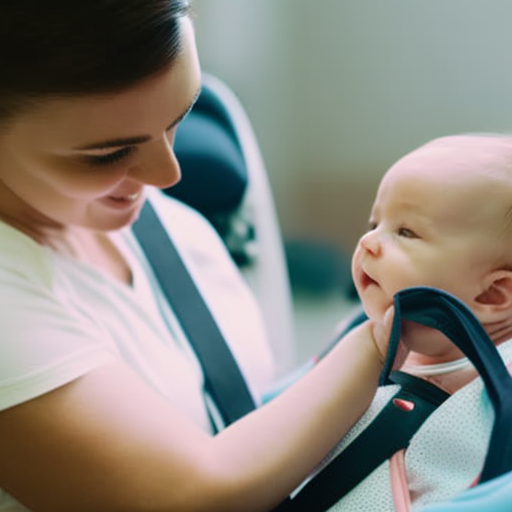
To ensure a secure fit for your baby in their car seat, properly adjusting the straps is essential. Here are some strap adjustment techniques and troubleshooting tips to help you achieve a snug fit:
-
Check the tightness: Pull the straps tight enough so that you can’t pinch any excess webbing. This will ensure that your baby is secure and won’t be able to move around too much during a car ride.
-
Position the chest clip: The chest clip should be positioned at armpit level. This helps to keep the straps in the correct position and prevents them from slipping off your baby’s shoulders.
-
Adjust the shoulder height: As your baby grows, you’ll need to adjust the shoulder height of the straps. Make sure they’re at or just below your baby’s shoulders to provide optimal protection.
-
Double-check the buckle: Ensure that the buckle is securely fastened and that the straps are properly threaded through it. This will prevent any accidental loosening or release of the straps during a car ride.
If you’re having trouble achieving a snug fit with the straps, here are some troubleshooting tips:
-
Remove bulky clothing: Bulky clothing can create a gap between your baby and the straps, compromising their safety. Remove any unnecessary layers before securing your baby in their car seat.
-
Use strap covers: Strap covers can help to provide a more comfortable fit for your baby and prevent any irritation from the straps rubbing against their skin.
-
Seek professional help: If you’ve tried all the adjustments and troubleshooting tips and still can’t achieve a snug fit, consider seeking help from a certified car seat technician. They can provide expert guidance and ensure that your baby is safely secured in their car seat.
Checking for Proper Recline Angle

Make sure you check the recline angle of your baby’s car seat to ensure proper positioning and safety. The recline angle is important because it helps keep your baby’s head from falling forward, which can obstruct their airway and cause breathing difficulties. It also helps to prevent their chin from touching their chest, which can restrict their ability to breathe properly.
To check the recline angle of your baby’s car seat, you can consult the manufacturer’s instructions. Many car seats have adjustable recline angles that can be changed to fit your baby’s needs as they grow. It’s important to make sure that the car seat is properly reclined for your baby’s age and size.
When adjusting the recline angle, be sure to follow the manufacturer’s guidelines. Some car seats have built-in recline indicators that show whether the seat is at the correct angle. Others may require you to use a towel or pool noodle to achieve the proper recline.
Keeping the Car Seat Clean and Well-Maintained
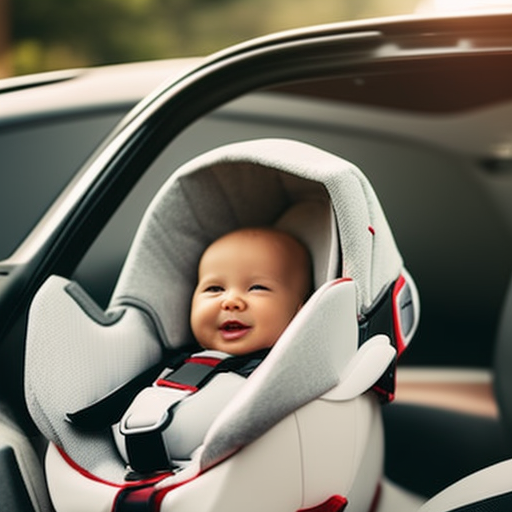
Regular cleaning and maintenance of your car seat is essential for ensuring its longevity and your baby’s safety. Here are some tips to help you keep your car seat clean and well-maintained:
-
Remove and wash the seat cover: Regularly remove the seat cover and wash it according to the manufacturer’s instructions. This will help prevent germ buildup and keep the seat fresh and clean for your baby.
-
Vacuum and wipe down the seat: Use a vacuum cleaner with a brush attachment to remove any crumbs or debris from the seat. Then, wipe down the seat with a damp cloth to remove any dirt or stains.
-
Check for loose straps and buckles: Regularly inspect the straps and buckles of the car seat to ensure they aren’t loose or damaged. Loose straps can compromise the safety of the seat and put your baby at risk.
-
Avoid harsh cleaning products: When cleaning your car seat, avoid using harsh cleaning products or chemicals that may damage the seat or irritate your baby’s sensitive skin. Instead, use mild soap and water or a baby-safe cleaning solution.
Avoiding Bulky Clothing and Accessories
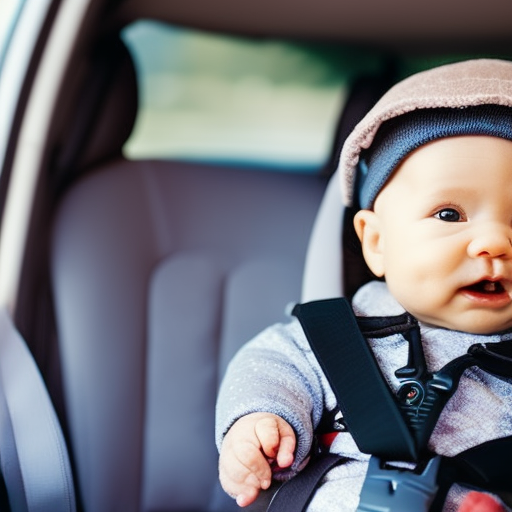
Wearing bulky clothing and accessories can pose a safety risk for your baby when using an infant car seat. While it may be tempting to bundle up your little one in thick layers for warmth, it’s important to remember that bulky clothing can prevent the car seat straps from fitting snugly around your baby. This can compromise the effectiveness of the seat in the event of a collision.
Instead, opt for layering to keep your baby warm. Start with a thin layer, such as a onesie, and then add a sweater or jacket. You can also use a blanket to provide extra warmth. Just make sure that the blanket is tucked in securely around your baby, and never place it between your baby and the car seat harness.
It’s also crucial to ensure proper positioning of your baby’s head and neck. Avoid using headrests or cushions that aren’t provided by the car seat manufacturer, as they can interfere with the seat’s safety features.
Never Leaving Your Baby Unattended in the Car Seat
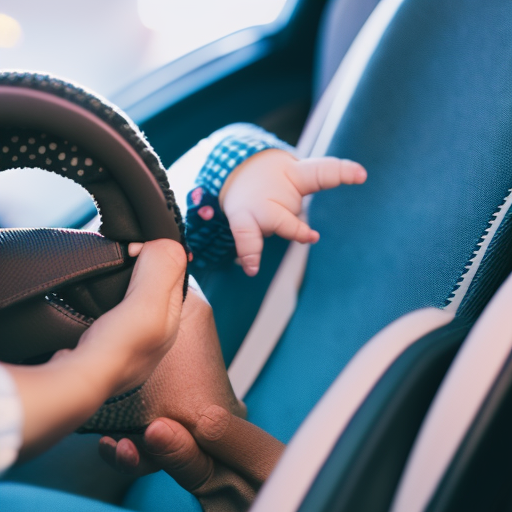
Remember to never leave your baby unattended in the car seat, as it poses a serious safety risk. It’s important to always supervise your baby while they’re in the car seat to ensure their well-being.
Here are some reasons why you should never leave your baby unattended in the car seat:
-
Baby’s comfort: Leaving your baby unattended in the car seat can lead to discomfort and potential health issues. Babies need to be moved and held regularly to prevent muscle and joint stiffness. By supervising your baby, you can ensure their comfort and prevent any unnecessary discomfort.
-
Importance of supervision: Supervision is crucial to ensure your baby’s safety. Leaving your baby unattended in the car seat puts them at risk of choking, overheating, or positional asphyxiation. By keeping a close eye on your baby, you can promptly address any potential hazards and provide immediate assistance if needed.
-
Prevention of accidents: Accidents can happen even in the safest of environments. By supervising your baby in the car seat, you can prevent accidents such as the car seat tipping over, objects falling on your baby, or the baby unbuckling themselves. Your attentive presence can prevent these accidents from occurring.
-
Peace of mind: Keeping a watchful eye on your baby in the car seat provides you with peace of mind. You can relax knowing that your baby is safe and secure, and you can quickly respond to their needs.
Staying Informed About Recalls and Safety Updates
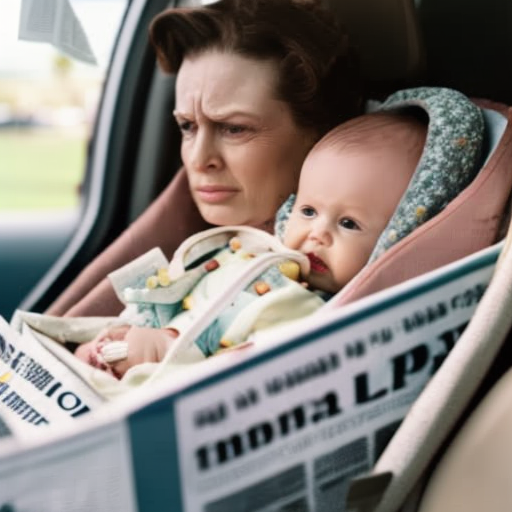
Staying informed about recalls and safety updates is essential for ensuring the ongoing safety of your infant car seat. Recall alerts are issued when a potential safety issue is identified with a specific car seat model. These alerts can be sent out by the manufacturer, the National Highway Traffic Safety Administration (NHTSA), or other relevant authorities. Being aware of these recalls is crucial because they may involve defects or malfunctions that could compromise the safety of your child.
To stay informed about recalls and safety updates, it’s important to register your car seat. By registering your car seat, you provide the manufacturer with your contact information, enabling them to notify you directly if a recall is issued for your specific model. Registration can usually be done online or by mail, and it only takes a few minutes of your time.
Additionally, make sure to regularly check the manufacturer’s website, the NHTSA website, and other reliable sources for any recall alerts or safety updates related to your infant car seat.
Frequently Asked Questions
How Can I Clean My Car Seat if It Gets Dirty?
If your car seat gets dirty, there are car seat cleaning hacks you can use to keep it looking fresh. Preventing car seat stains is important for your baby’s safety and comfort. Here’s how you can clean your car seat if it gets dirty.
Can I Use a Car Seat That Has Been Involved in a Previous Car Accident?
Yes, you should replace a car seat that has been involved in a previous car accident. Even if it appears undamaged, the seat’s structural integrity may be compromised. It’s also important to regularly check the expiration dates on car seats.
How Often Should I Check for Recalls and Safety Updates for My Car Seat?
You should check for recalls and safety updates for your car seat regularly. This ensures that you are aware of any potential issues and can take the necessary steps to keep your baby safe.
Are There Any Specific Guidelines for Using Car Seats in Cold Weather?
In cold weather, it’s important to take safety precautions when using a car seat. Make sure you properly install the seat and always dress your baby in warm layers. Stay cozy and safe!
Can I Use Accessories Like Head Supports or Car Seat Covers With My Infant Car Seat?
You should avoid using accessories like head supports or car seat covers with your infant car seat. These can interfere with the proper fit and function of the seat, compromising your baby’s safety.
Conclusion
You now have the knowledge to keep your infant safe in their car seat. Remember, rear-facing is the safest option, and always choose a seat that fits your baby’s weight and height. Proper installation and securing your baby with the harness are crucial.
Did you know that car crashes are the leading cause of death for children aged 1-13? By following these safety tips, you can help prevent tragic accidents and keep your little one protected.
Stay informed and prioritize your baby’s safety.


